Business Environment: Shell Company Analysis and Report Details
VerifiedAdded on 2023/01/18
|16
|4877
|65
Report
AI Summary
This report provides a comprehensive analysis of the business environment, focusing on the Shell company. It begins by explaining different organizational forms (public, private, and voluntary) and their characteristics, including size, scope, and legal structures, using examples like NHS, Shell, and Oxfam. The report then explores the relationship between various organizational functions such as HR, marketing, and finance, highlighting how these departments are interconnected and contribute to overall organizational objectives. Furthermore, it examines the positive and negative impacts of the macro environment on business operations, followed by an application of SWOT analysis and Porter's Five Forces to assess Shell's internal and external environments. The report concludes by illustrating the interrelation between internal and external factors, offering insights into how these elements influence business strategies and performance.
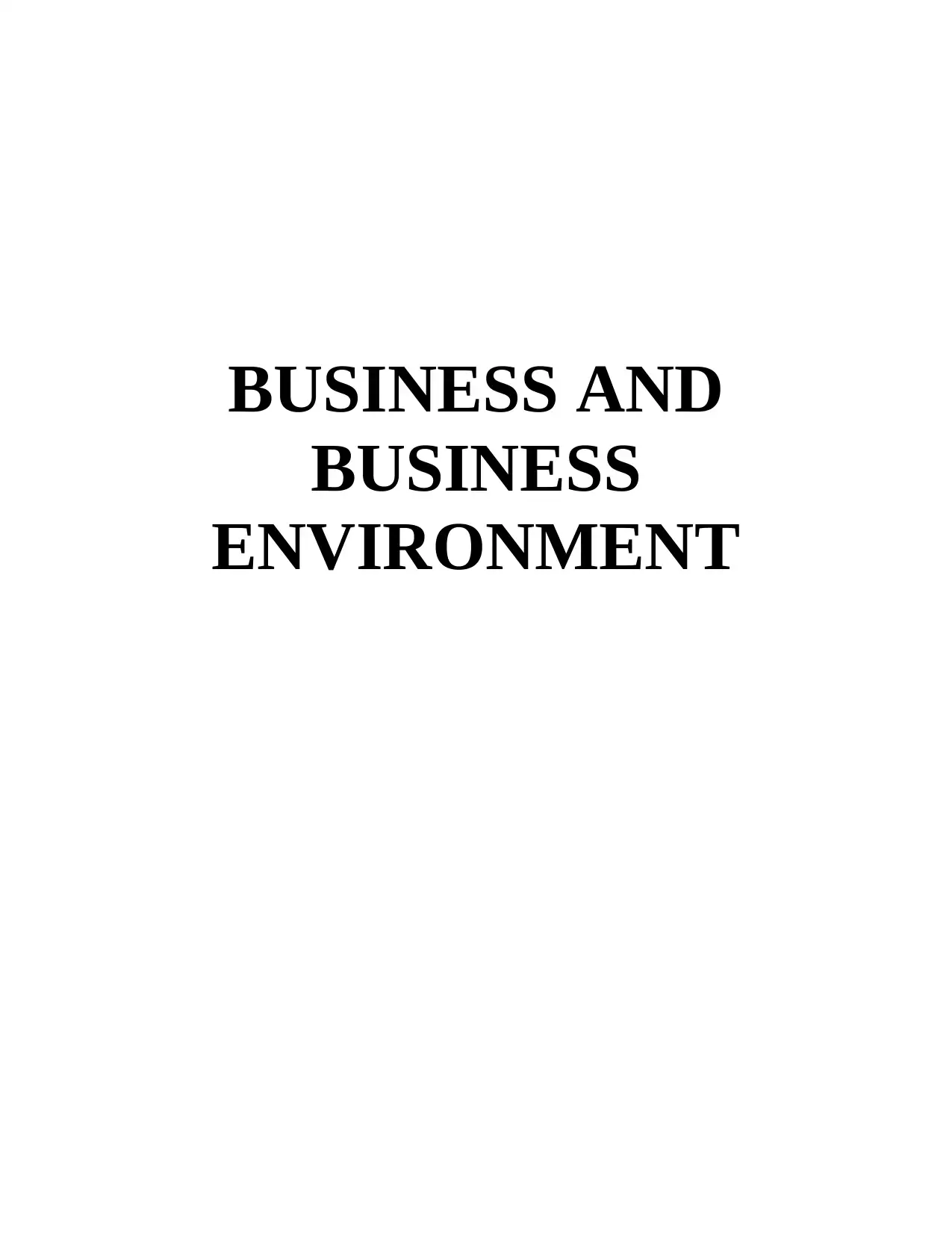
BUSINESS AND
BUSINESS
ENVIRONMENT
BUSINESS
ENVIRONMENT
Paraphrase This Document
Need a fresh take? Get an instant paraphrase of this document with our AI Paraphraser
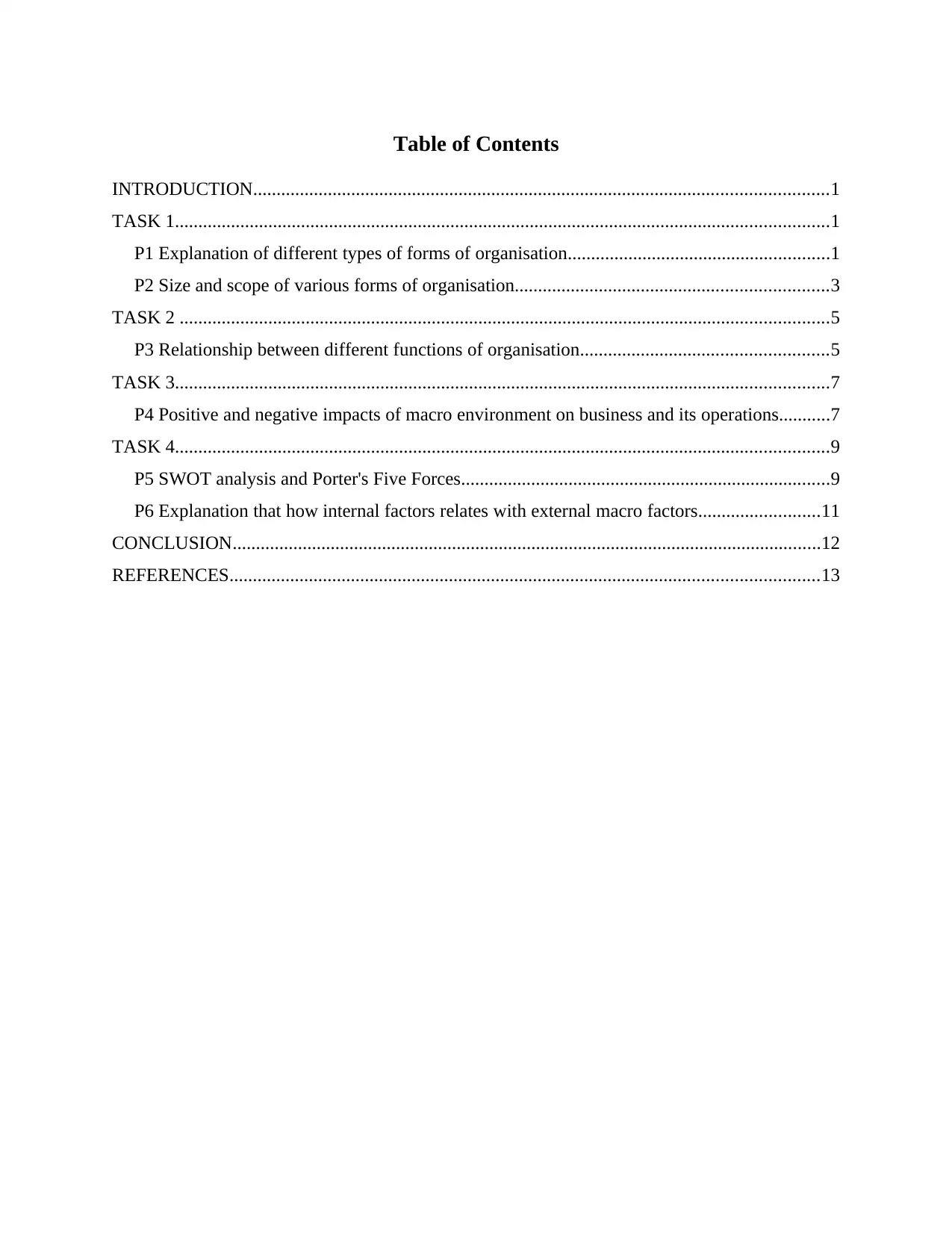
Table of Contents
INTRODUCTION...........................................................................................................................1
TASK 1............................................................................................................................................1
P1 Explanation of different types of forms of organisation........................................................1
P2 Size and scope of various forms of organisation...................................................................3
TASK 2 ...........................................................................................................................................5
P3 Relationship between different functions of organisation.....................................................5
TASK 3............................................................................................................................................7
P4 Positive and negative impacts of macro environment on business and its operations...........7
TASK 4............................................................................................................................................9
P5 SWOT analysis and Porter's Five Forces...............................................................................9
P6 Explanation that how internal factors relates with external macro factors..........................11
CONCLUSION..............................................................................................................................12
REFERENCES..............................................................................................................................13
INTRODUCTION...........................................................................................................................1
TASK 1............................................................................................................................................1
P1 Explanation of different types of forms of organisation........................................................1
P2 Size and scope of various forms of organisation...................................................................3
TASK 2 ...........................................................................................................................................5
P3 Relationship between different functions of organisation.....................................................5
TASK 3............................................................................................................................................7
P4 Positive and negative impacts of macro environment on business and its operations...........7
TASK 4............................................................................................................................................9
P5 SWOT analysis and Porter's Five Forces...............................................................................9
P6 Explanation that how internal factors relates with external macro factors..........................11
CONCLUSION..............................................................................................................................12
REFERENCES..............................................................................................................................13
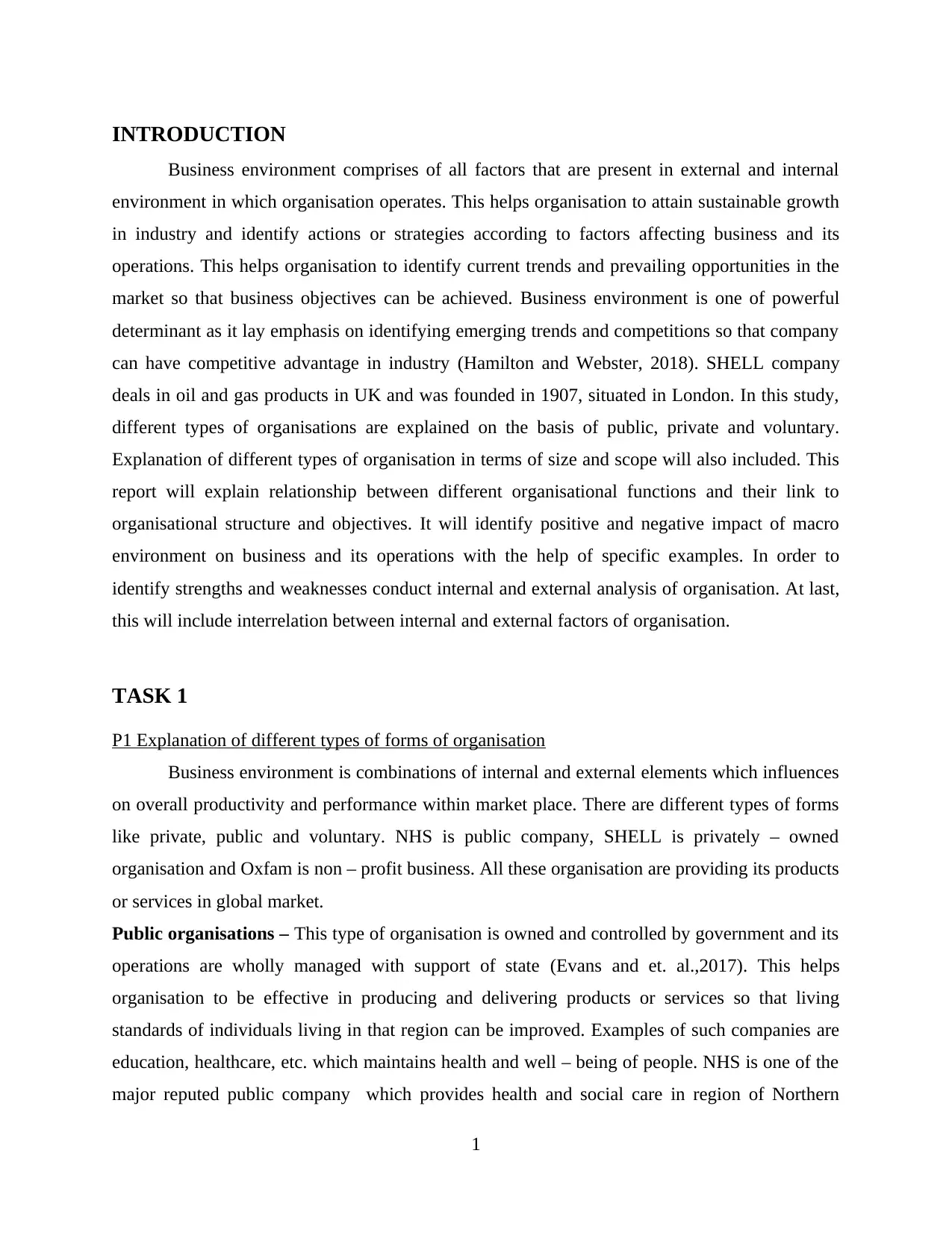
INTRODUCTION
Business environment comprises of all factors that are present in external and internal
environment in which organisation operates. This helps organisation to attain sustainable growth
in industry and identify actions or strategies according to factors affecting business and its
operations. This helps organisation to identify current trends and prevailing opportunities in the
market so that business objectives can be achieved. Business environment is one of powerful
determinant as it lay emphasis on identifying emerging trends and competitions so that company
can have competitive advantage in industry (Hamilton and Webster, 2018). SHELL company
deals in oil and gas products in UK and was founded in 1907, situated in London. In this study,
different types of organisations are explained on the basis of public, private and voluntary.
Explanation of different types of organisation in terms of size and scope will also included. This
report will explain relationship between different organisational functions and their link to
organisational structure and objectives. It will identify positive and negative impact of macro
environment on business and its operations with the help of specific examples. In order to
identify strengths and weaknesses conduct internal and external analysis of organisation. At last,
this will include interrelation between internal and external factors of organisation.
TASK 1
P1 Explanation of different types of forms of organisation
Business environment is combinations of internal and external elements which influences
on overall productivity and performance within market place. There are different types of forms
like private, public and voluntary. NHS is public company, SHELL is privately – owned
organisation and Oxfam is non – profit business. All these organisation are providing its products
or services in global market.
Public organisations – This type of organisation is owned and controlled by government and its
operations are wholly managed with support of state (Evans and et. al.,2017). This helps
organisation to be effective in producing and delivering products or services so that living
standards of individuals living in that region can be improved. Examples of such companies are
education, healthcare, etc. which maintains health and well – being of people. NHS is one of the
major reputed public company which provides health and social care in region of Northern
1
Business environment comprises of all factors that are present in external and internal
environment in which organisation operates. This helps organisation to attain sustainable growth
in industry and identify actions or strategies according to factors affecting business and its
operations. This helps organisation to identify current trends and prevailing opportunities in the
market so that business objectives can be achieved. Business environment is one of powerful
determinant as it lay emphasis on identifying emerging trends and competitions so that company
can have competitive advantage in industry (Hamilton and Webster, 2018). SHELL company
deals in oil and gas products in UK and was founded in 1907, situated in London. In this study,
different types of organisations are explained on the basis of public, private and voluntary.
Explanation of different types of organisation in terms of size and scope will also included. This
report will explain relationship between different organisational functions and their link to
organisational structure and objectives. It will identify positive and negative impact of macro
environment on business and its operations with the help of specific examples. In order to
identify strengths and weaknesses conduct internal and external analysis of organisation. At last,
this will include interrelation between internal and external factors of organisation.
TASK 1
P1 Explanation of different types of forms of organisation
Business environment is combinations of internal and external elements which influences
on overall productivity and performance within market place. There are different types of forms
like private, public and voluntary. NHS is public company, SHELL is privately – owned
organisation and Oxfam is non – profit business. All these organisation are providing its products
or services in global market.
Public organisations – This type of organisation is owned and controlled by government and its
operations are wholly managed with support of state (Evans and et. al.,2017). This helps
organisation to be effective in producing and delivering products or services so that living
standards of individuals living in that region can be improved. Examples of such companies are
education, healthcare, etc. which maintains health and well – being of people. NHS is one of the
major reputed public company which provides health and social care in region of Northern
1
⊘ This is a preview!⊘
Do you want full access?
Subscribe today to unlock all pages.

Trusted by 1+ million students worldwide
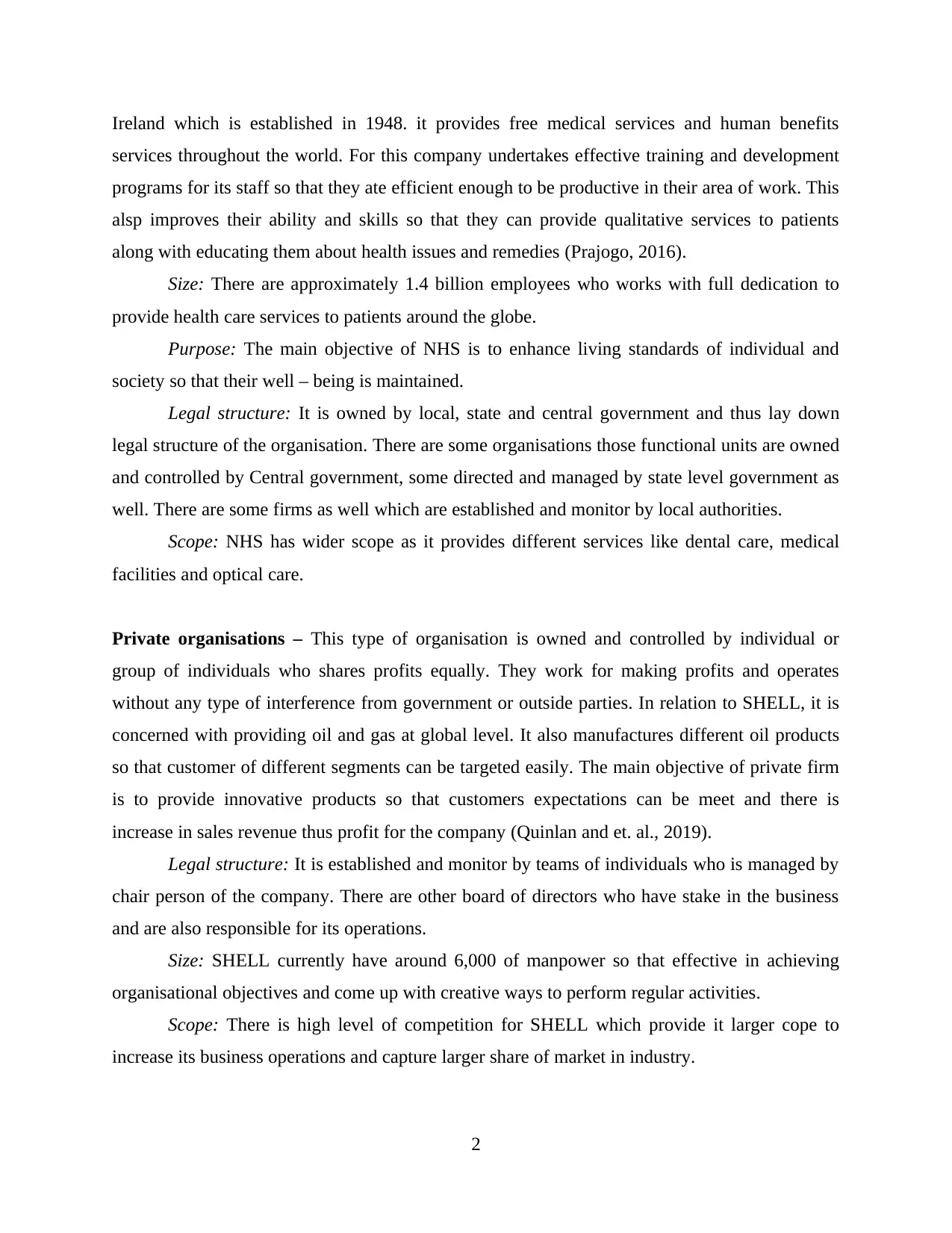
Ireland which is established in 1948. it provides free medical services and human benefits
services throughout the world. For this company undertakes effective training and development
programs for its staff so that they ate efficient enough to be productive in their area of work. This
alsp improves their ability and skills so that they can provide qualitative services to patients
along with educating them about health issues and remedies (Prajogo, 2016).
Size: There are approximately 1.4 billion employees who works with full dedication to
provide health care services to patients around the globe.
Purpose: The main objective of NHS is to enhance living standards of individual and
society so that their well – being is maintained.
Legal structure: It is owned by local, state and central government and thus lay down
legal structure of the organisation. There are some organisations those functional units are owned
and controlled by Central government, some directed and managed by state level government as
well. There are some firms as well which are established and monitor by local authorities.
Scope: NHS has wider scope as it provides different services like dental care, medical
facilities and optical care.
Private organisations – This type of organisation is owned and controlled by individual or
group of individuals who shares profits equally. They work for making profits and operates
without any type of interference from government or outside parties. In relation to SHELL, it is
concerned with providing oil and gas at global level. It also manufactures different oil products
so that customer of different segments can be targeted easily. The main objective of private firm
is to provide innovative products so that customers expectations can be meet and there is
increase in sales revenue thus profit for the company (Quinlan and et. al., 2019).
Legal structure: It is established and monitor by teams of individuals who is managed by
chair person of the company. There are other board of directors who have stake in the business
and are also responsible for its operations.
Size: SHELL currently have around 6,000 of manpower so that effective in achieving
organisational objectives and come up with creative ways to perform regular activities.
Scope: There is high level of competition for SHELL which provide it larger cope to
increase its business operations and capture larger share of market in industry.
2
services throughout the world. For this company undertakes effective training and development
programs for its staff so that they ate efficient enough to be productive in their area of work. This
alsp improves their ability and skills so that they can provide qualitative services to patients
along with educating them about health issues and remedies (Prajogo, 2016).
Size: There are approximately 1.4 billion employees who works with full dedication to
provide health care services to patients around the globe.
Purpose: The main objective of NHS is to enhance living standards of individual and
society so that their well – being is maintained.
Legal structure: It is owned by local, state and central government and thus lay down
legal structure of the organisation. There are some organisations those functional units are owned
and controlled by Central government, some directed and managed by state level government as
well. There are some firms as well which are established and monitor by local authorities.
Scope: NHS has wider scope as it provides different services like dental care, medical
facilities and optical care.
Private organisations – This type of organisation is owned and controlled by individual or
group of individuals who shares profits equally. They work for making profits and operates
without any type of interference from government or outside parties. In relation to SHELL, it is
concerned with providing oil and gas at global level. It also manufactures different oil products
so that customer of different segments can be targeted easily. The main objective of private firm
is to provide innovative products so that customers expectations can be meet and there is
increase in sales revenue thus profit for the company (Quinlan and et. al., 2019).
Legal structure: It is established and monitor by teams of individuals who is managed by
chair person of the company. There are other board of directors who have stake in the business
and are also responsible for its operations.
Size: SHELL currently have around 6,000 of manpower so that effective in achieving
organisational objectives and come up with creative ways to perform regular activities.
Scope: There is high level of competition for SHELL which provide it larger cope to
increase its business operations and capture larger share of market in industry.
2
Paraphrase This Document
Need a fresh take? Get an instant paraphrase of this document with our AI Paraphraser
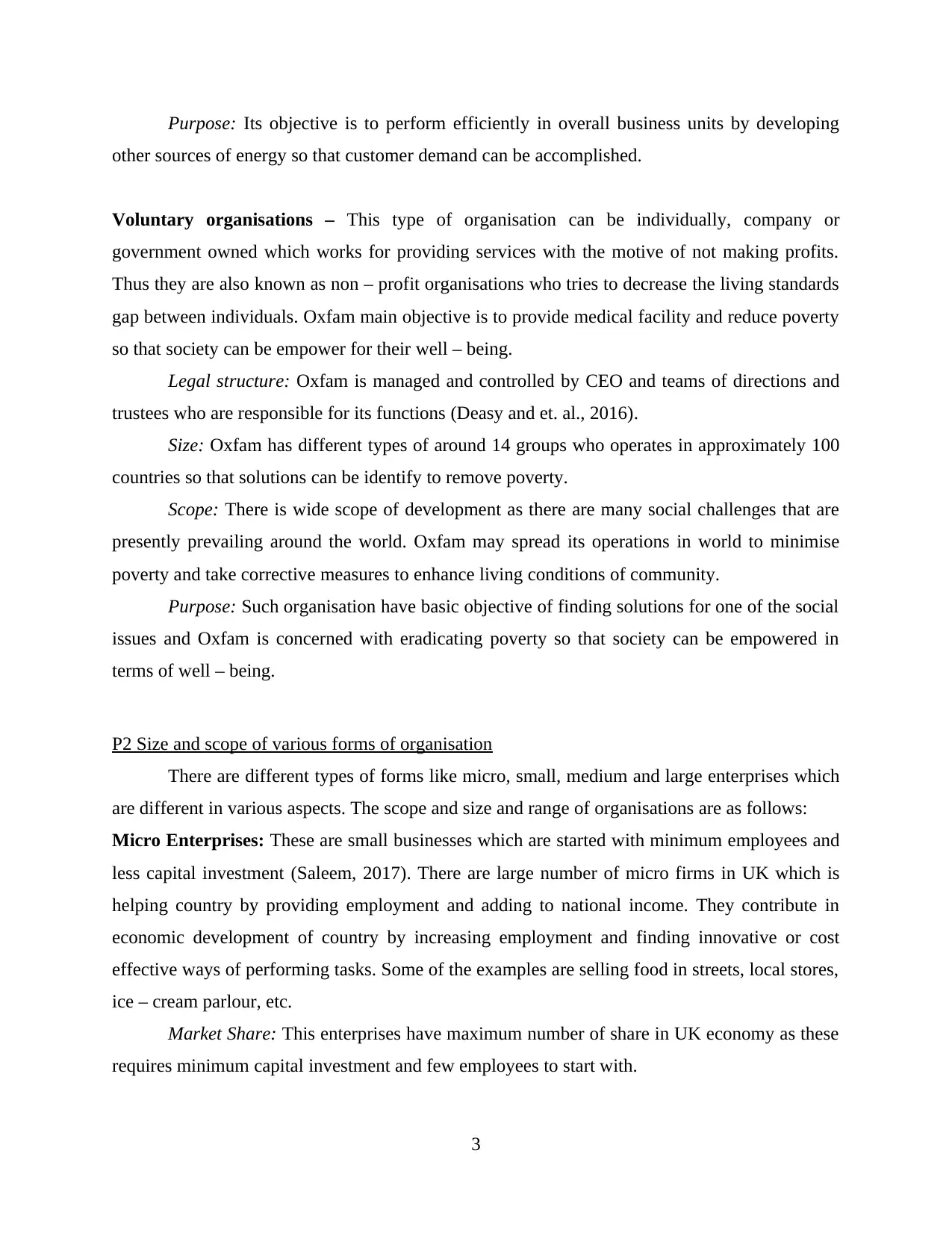
Purpose: Its objective is to perform efficiently in overall business units by developing
other sources of energy so that customer demand can be accomplished.
Voluntary organisations – This type of organisation can be individually, company or
government owned which works for providing services with the motive of not making profits.
Thus they are also known as non – profit organisations who tries to decrease the living standards
gap between individuals. Oxfam main objective is to provide medical facility and reduce poverty
so that society can be empower for their well – being.
Legal structure: Oxfam is managed and controlled by CEO and teams of directions and
trustees who are responsible for its functions (Deasy and et. al., 2016).
Size: Oxfam has different types of around 14 groups who operates in approximately 100
countries so that solutions can be identify to remove poverty.
Scope: There is wide scope of development as there are many social challenges that are
presently prevailing around the world. Oxfam may spread its operations in world to minimise
poverty and take corrective measures to enhance living conditions of community.
Purpose: Such organisation have basic objective of finding solutions for one of the social
issues and Oxfam is concerned with eradicating poverty so that society can be empowered in
terms of well – being.
P2 Size and scope of various forms of organisation
There are different types of forms like micro, small, medium and large enterprises which
are different in various aspects. The scope and size and range of organisations are as follows:
Micro Enterprises: These are small businesses which are started with minimum employees and
less capital investment (Saleem, 2017). There are large number of micro firms in UK which is
helping country by providing employment and adding to national income. They contribute in
economic development of country by increasing employment and finding innovative or cost
effective ways of performing tasks. Some of the examples are selling food in streets, local stores,
ice – cream parlour, etc.
Market Share: This enterprises have maximum number of share in UK economy as these
requires minimum capital investment and few employees to start with.
3
other sources of energy so that customer demand can be accomplished.
Voluntary organisations – This type of organisation can be individually, company or
government owned which works for providing services with the motive of not making profits.
Thus they are also known as non – profit organisations who tries to decrease the living standards
gap between individuals. Oxfam main objective is to provide medical facility and reduce poverty
so that society can be empower for their well – being.
Legal structure: Oxfam is managed and controlled by CEO and teams of directions and
trustees who are responsible for its functions (Deasy and et. al., 2016).
Size: Oxfam has different types of around 14 groups who operates in approximately 100
countries so that solutions can be identify to remove poverty.
Scope: There is wide scope of development as there are many social challenges that are
presently prevailing around the world. Oxfam may spread its operations in world to minimise
poverty and take corrective measures to enhance living conditions of community.
Purpose: Such organisation have basic objective of finding solutions for one of the social
issues and Oxfam is concerned with eradicating poverty so that society can be empowered in
terms of well – being.
P2 Size and scope of various forms of organisation
There are different types of forms like micro, small, medium and large enterprises which
are different in various aspects. The scope and size and range of organisations are as follows:
Micro Enterprises: These are small businesses which are started with minimum employees and
less capital investment (Saleem, 2017). There are large number of micro firms in UK which is
helping country by providing employment and adding to national income. They contribute in
economic development of country by increasing employment and finding innovative or cost
effective ways of performing tasks. Some of the examples are selling food in streets, local stores,
ice – cream parlour, etc.
Market Share: This enterprises have maximum number of share in UK economy as these
requires minimum capital investment and few employees to start with.
3
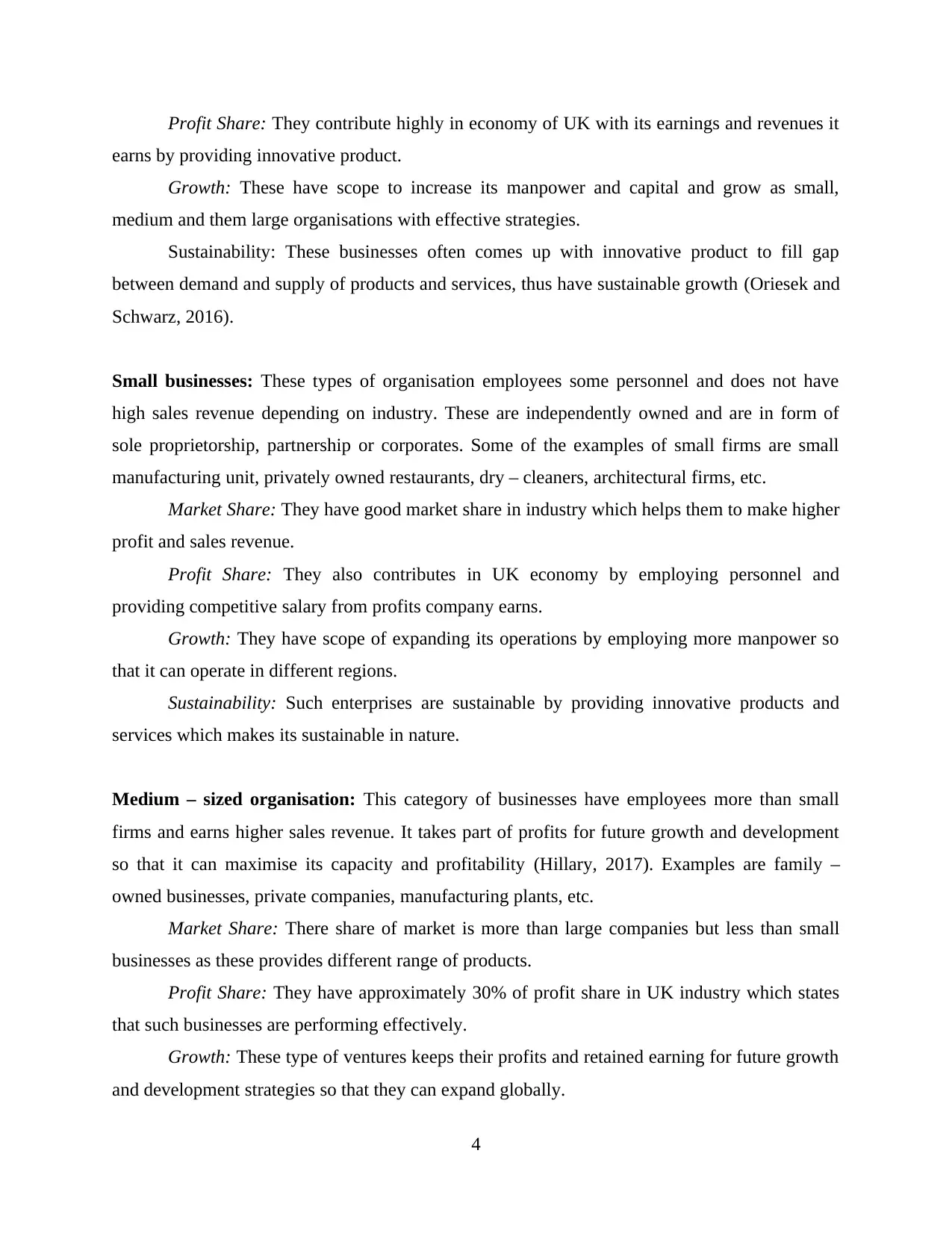
Profit Share: They contribute highly in economy of UK with its earnings and revenues it
earns by providing innovative product.
Growth: These have scope to increase its manpower and capital and grow as small,
medium and them large organisations with effective strategies.
Sustainability: These businesses often comes up with innovative product to fill gap
between demand and supply of products and services, thus have sustainable growth (Oriesek and
Schwarz, 2016).
Small businesses: These types of organisation employees some personnel and does not have
high sales revenue depending on industry. These are independently owned and are in form of
sole proprietorship, partnership or corporates. Some of the examples of small firms are small
manufacturing unit, privately owned restaurants, dry – cleaners, architectural firms, etc.
Market Share: They have good market share in industry which helps them to make higher
profit and sales revenue.
Profit Share: They also contributes in UK economy by employing personnel and
providing competitive salary from profits company earns.
Growth: They have scope of expanding its operations by employing more manpower so
that it can operate in different regions.
Sustainability: Such enterprises are sustainable by providing innovative products and
services which makes its sustainable in nature.
Medium – sized organisation: This category of businesses have employees more than small
firms and earns higher sales revenue. It takes part of profits for future growth and development
so that it can maximise its capacity and profitability (Hillary, 2017). Examples are family –
owned businesses, private companies, manufacturing plants, etc.
Market Share: There share of market is more than large companies but less than small
businesses as these provides different range of products.
Profit Share: They have approximately 30% of profit share in UK industry which states
that such businesses are performing effectively.
Growth: These type of ventures keeps their profits and retained earning for future growth
and development strategies so that they can expand globally.
4
earns by providing innovative product.
Growth: These have scope to increase its manpower and capital and grow as small,
medium and them large organisations with effective strategies.
Sustainability: These businesses often comes up with innovative product to fill gap
between demand and supply of products and services, thus have sustainable growth (Oriesek and
Schwarz, 2016).
Small businesses: These types of organisation employees some personnel and does not have
high sales revenue depending on industry. These are independently owned and are in form of
sole proprietorship, partnership or corporates. Some of the examples of small firms are small
manufacturing unit, privately owned restaurants, dry – cleaners, architectural firms, etc.
Market Share: They have good market share in industry which helps them to make higher
profit and sales revenue.
Profit Share: They also contributes in UK economy by employing personnel and
providing competitive salary from profits company earns.
Growth: They have scope of expanding its operations by employing more manpower so
that it can operate in different regions.
Sustainability: Such enterprises are sustainable by providing innovative products and
services which makes its sustainable in nature.
Medium – sized organisation: This category of businesses have employees more than small
firms and earns higher sales revenue. It takes part of profits for future growth and development
so that it can maximise its capacity and profitability (Hillary, 2017). Examples are family –
owned businesses, private companies, manufacturing plants, etc.
Market Share: There share of market is more than large companies but less than small
businesses as these provides different range of products.
Profit Share: They have approximately 30% of profit share in UK industry which states
that such businesses are performing effectively.
Growth: These type of ventures keeps their profits and retained earning for future growth
and development strategies so that they can expand globally.
4
⊘ This is a preview!⊘
Do you want full access?
Subscribe today to unlock all pages.

Trusted by 1+ million students worldwide
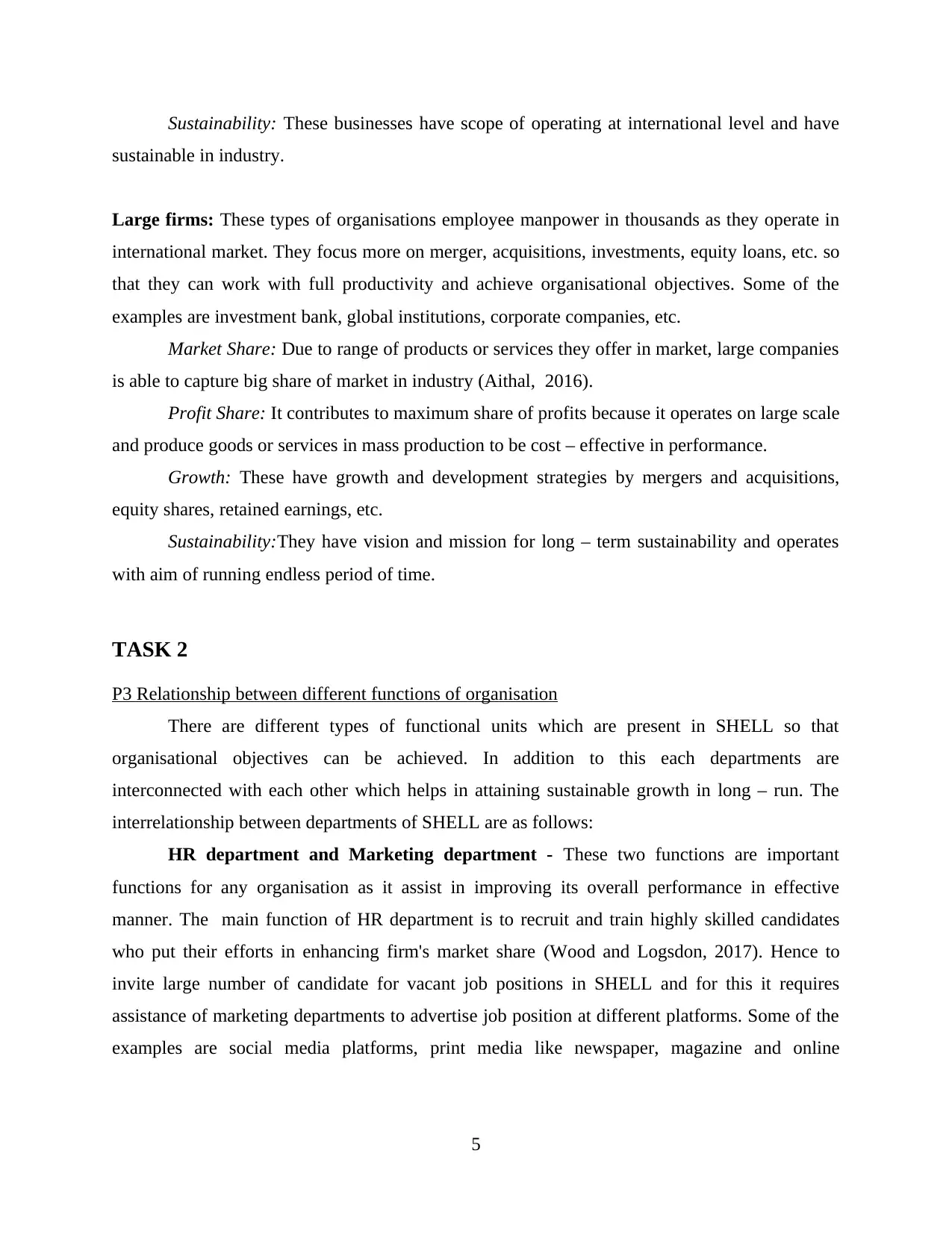
Sustainability: These businesses have scope of operating at international level and have
sustainable in industry.
Large firms: These types of organisations employee manpower in thousands as they operate in
international market. They focus more on merger, acquisitions, investments, equity loans, etc. so
that they can work with full productivity and achieve organisational objectives. Some of the
examples are investment bank, global institutions, corporate companies, etc.
Market Share: Due to range of products or services they offer in market, large companies
is able to capture big share of market in industry (Aithal, 2016).
Profit Share: It contributes to maximum share of profits because it operates on large scale
and produce goods or services in mass production to be cost – effective in performance.
Growth: These have growth and development strategies by mergers and acquisitions,
equity shares, retained earnings, etc.
Sustainability:They have vision and mission for long – term sustainability and operates
with aim of running endless period of time.
TASK 2
P3 Relationship between different functions of organisation
There are different types of functional units which are present in SHELL so that
organisational objectives can be achieved. In addition to this each departments are
interconnected with each other which helps in attaining sustainable growth in long – run. The
interrelationship between departments of SHELL are as follows:
HR department and Marketing department - These two functions are important
functions for any organisation as it assist in improving its overall performance in effective
manner. The main function of HR department is to recruit and train highly skilled candidates
who put their efforts in enhancing firm's market share (Wood and Logsdon, 2017). Hence to
invite large number of candidate for vacant job positions in SHELL and for this it requires
assistance of marketing departments to advertise job position at different platforms. Some of the
examples are social media platforms, print media like newspaper, magazine and online
5
sustainable in industry.
Large firms: These types of organisations employee manpower in thousands as they operate in
international market. They focus more on merger, acquisitions, investments, equity loans, etc. so
that they can work with full productivity and achieve organisational objectives. Some of the
examples are investment bank, global institutions, corporate companies, etc.
Market Share: Due to range of products or services they offer in market, large companies
is able to capture big share of market in industry (Aithal, 2016).
Profit Share: It contributes to maximum share of profits because it operates on large scale
and produce goods or services in mass production to be cost – effective in performance.
Growth: These have growth and development strategies by mergers and acquisitions,
equity shares, retained earnings, etc.
Sustainability:They have vision and mission for long – term sustainability and operates
with aim of running endless period of time.
TASK 2
P3 Relationship between different functions of organisation
There are different types of functional units which are present in SHELL so that
organisational objectives can be achieved. In addition to this each departments are
interconnected with each other which helps in attaining sustainable growth in long – run. The
interrelationship between departments of SHELL are as follows:
HR department and Marketing department - These two functions are important
functions for any organisation as it assist in improving its overall performance in effective
manner. The main function of HR department is to recruit and train highly skilled candidates
who put their efforts in enhancing firm's market share (Wood and Logsdon, 2017). Hence to
invite large number of candidate for vacant job positions in SHELL and for this it requires
assistance of marketing departments to advertise job position at different platforms. Some of the
examples are social media platforms, print media like newspaper, magazine and online
5
Paraphrase This Document
Need a fresh take? Get an instant paraphrase of this document with our AI Paraphraser
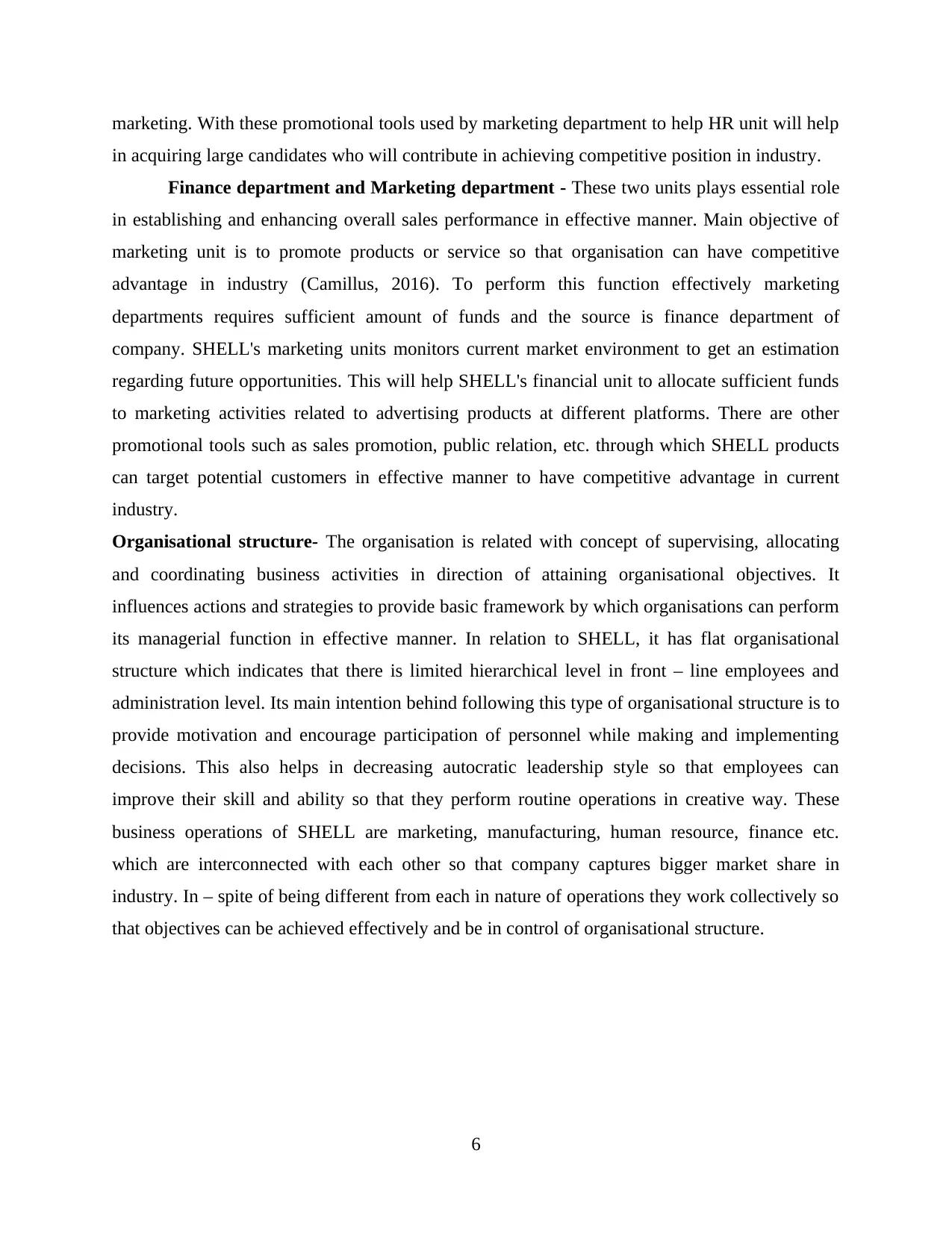
marketing. With these promotional tools used by marketing department to help HR unit will help
in acquiring large candidates who will contribute in achieving competitive position in industry.
Finance department and Marketing department - These two units plays essential role
in establishing and enhancing overall sales performance in effective manner. Main objective of
marketing unit is to promote products or service so that organisation can have competitive
advantage in industry (Camillus, 2016). To perform this function effectively marketing
departments requires sufficient amount of funds and the source is finance department of
company. SHELL's marketing units monitors current market environment to get an estimation
regarding future opportunities. This will help SHELL's financial unit to allocate sufficient funds
to marketing activities related to advertising products at different platforms. There are other
promotional tools such as sales promotion, public relation, etc. through which SHELL products
can target potential customers in effective manner to have competitive advantage in current
industry.
Organisational structure- The organisation is related with concept of supervising, allocating
and coordinating business activities in direction of attaining organisational objectives. It
influences actions and strategies to provide basic framework by which organisations can perform
its managerial function in effective manner. In relation to SHELL, it has flat organisational
structure which indicates that there is limited hierarchical level in front – line employees and
administration level. Its main intention behind following this type of organisational structure is to
provide motivation and encourage participation of personnel while making and implementing
decisions. This also helps in decreasing autocratic leadership style so that employees can
improve their skill and ability so that they perform routine operations in creative way. These
business operations of SHELL are marketing, manufacturing, human resource, finance etc.
which are interconnected with each other so that company captures bigger market share in
industry. In – spite of being different from each in nature of operations they work collectively so
that objectives can be achieved effectively and be in control of organisational structure.
6
in acquiring large candidates who will contribute in achieving competitive position in industry.
Finance department and Marketing department - These two units plays essential role
in establishing and enhancing overall sales performance in effective manner. Main objective of
marketing unit is to promote products or service so that organisation can have competitive
advantage in industry (Camillus, 2016). To perform this function effectively marketing
departments requires sufficient amount of funds and the source is finance department of
company. SHELL's marketing units monitors current market environment to get an estimation
regarding future opportunities. This will help SHELL's financial unit to allocate sufficient funds
to marketing activities related to advertising products at different platforms. There are other
promotional tools such as sales promotion, public relation, etc. through which SHELL products
can target potential customers in effective manner to have competitive advantage in current
industry.
Organisational structure- The organisation is related with concept of supervising, allocating
and coordinating business activities in direction of attaining organisational objectives. It
influences actions and strategies to provide basic framework by which organisations can perform
its managerial function in effective manner. In relation to SHELL, it has flat organisational
structure which indicates that there is limited hierarchical level in front – line employees and
administration level. Its main intention behind following this type of organisational structure is to
provide motivation and encourage participation of personnel while making and implementing
decisions. This also helps in decreasing autocratic leadership style so that employees can
improve their skill and ability so that they perform routine operations in creative way. These
business operations of SHELL are marketing, manufacturing, human resource, finance etc.
which are interconnected with each other so that company captures bigger market share in
industry. In – spite of being different from each in nature of operations they work collectively so
that objectives can be achieved effectively and be in control of organisational structure.
6
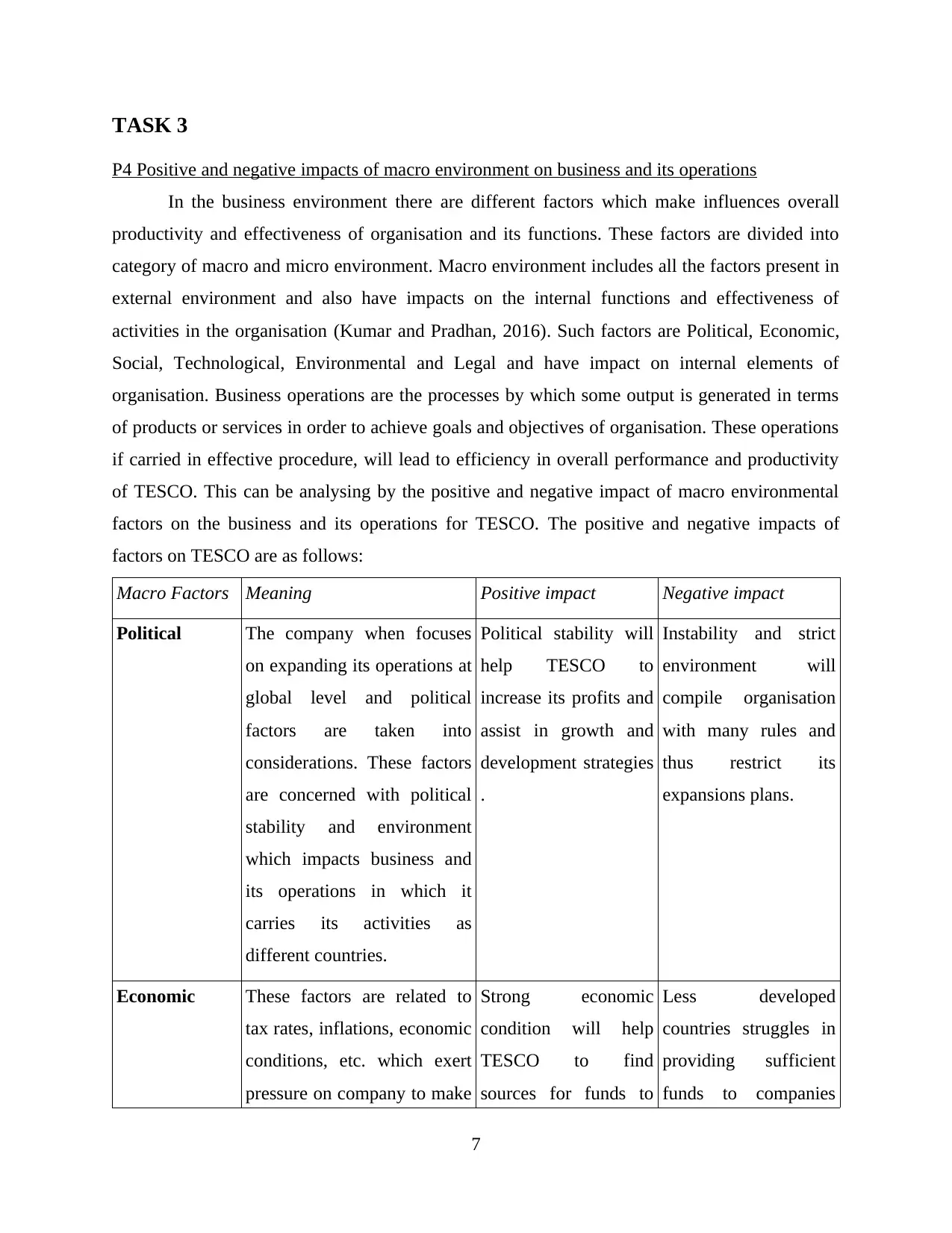
TASK 3
P4 Positive and negative impacts of macro environment on business and its operations
In the business environment there are different factors which make influences overall
productivity and effectiveness of organisation and its functions. These factors are divided into
category of macro and micro environment. Macro environment includes all the factors present in
external environment and also have impacts on the internal functions and effectiveness of
activities in the organisation (Kumar and Pradhan, 2016). Such factors are Political, Economic,
Social, Technological, Environmental and Legal and have impact on internal elements of
organisation. Business operations are the processes by which some output is generated in terms
of products or services in order to achieve goals and objectives of organisation. These operations
if carried in effective procedure, will lead to efficiency in overall performance and productivity
of TESCO. This can be analysing by the positive and negative impact of macro environmental
factors on the business and its operations for TESCO. The positive and negative impacts of
factors on TESCO are as follows:
Macro Factors Meaning Positive impact Negative impact
Political The company when focuses
on expanding its operations at
global level and political
factors are taken into
considerations. These factors
are concerned with political
stability and environment
which impacts business and
its operations in which it
carries its activities as
different countries.
Political stability will
help TESCO to
increase its profits and
assist in growth and
development strategies
.
Instability and strict
environment will
compile organisation
with many rules and
thus restrict its
expansions plans.
Economic These factors are related to
tax rates, inflations, economic
conditions, etc. which exert
pressure on company to make
Strong economic
condition will help
TESCO to find
sources for funds to
Less developed
countries struggles in
providing sufficient
funds to companies
7
P4 Positive and negative impacts of macro environment on business and its operations
In the business environment there are different factors which make influences overall
productivity and effectiveness of organisation and its functions. These factors are divided into
category of macro and micro environment. Macro environment includes all the factors present in
external environment and also have impacts on the internal functions and effectiveness of
activities in the organisation (Kumar and Pradhan, 2016). Such factors are Political, Economic,
Social, Technological, Environmental and Legal and have impact on internal elements of
organisation. Business operations are the processes by which some output is generated in terms
of products or services in order to achieve goals and objectives of organisation. These operations
if carried in effective procedure, will lead to efficiency in overall performance and productivity
of TESCO. This can be analysing by the positive and negative impact of macro environmental
factors on the business and its operations for TESCO. The positive and negative impacts of
factors on TESCO are as follows:
Macro Factors Meaning Positive impact Negative impact
Political The company when focuses
on expanding its operations at
global level and political
factors are taken into
considerations. These factors
are concerned with political
stability and environment
which impacts business and
its operations in which it
carries its activities as
different countries.
Political stability will
help TESCO to
increase its profits and
assist in growth and
development strategies
.
Instability and strict
environment will
compile organisation
with many rules and
thus restrict its
expansions plans.
Economic These factors are related to
tax rates, inflations, economic
conditions, etc. which exert
pressure on company to make
Strong economic
condition will help
TESCO to find
sources for funds to
Less developed
countries struggles in
providing sufficient
funds to companies
7
⊘ This is a preview!⊘
Do you want full access?
Subscribe today to unlock all pages.

Trusted by 1+ million students worldwide
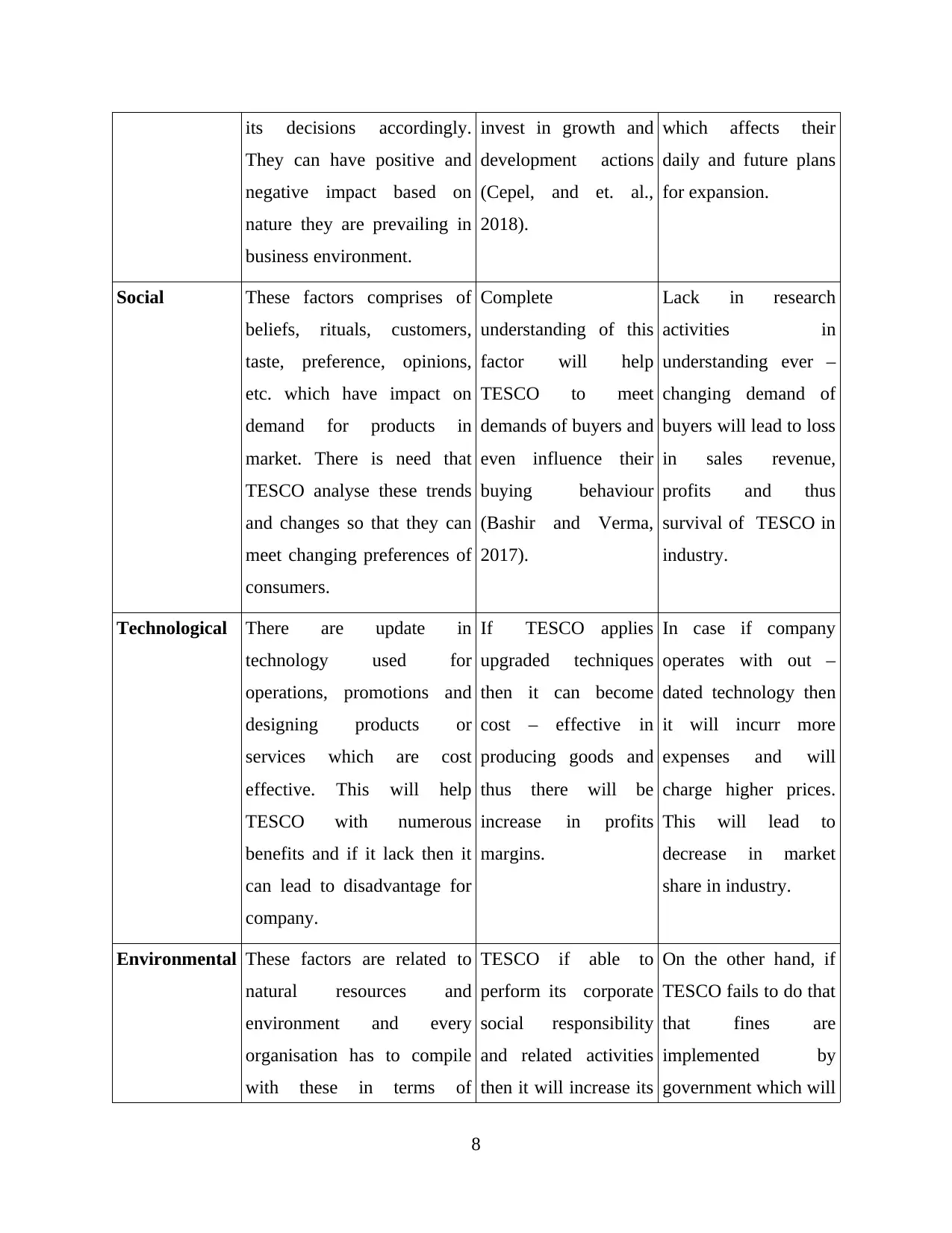
its decisions accordingly.
They can have positive and
negative impact based on
nature they are prevailing in
business environment.
invest in growth and
development actions
(Cepel, and et. al.,
2018).
which affects their
daily and future plans
for expansion.
Social These factors comprises of
beliefs, rituals, customers,
taste, preference, opinions,
etc. which have impact on
demand for products in
market. There is need that
TESCO analyse these trends
and changes so that they can
meet changing preferences of
consumers.
Complete
understanding of this
factor will help
TESCO to meet
demands of buyers and
even influence their
buying behaviour
(Bashir and Verma,
2017).
Lack in research
activities in
understanding ever –
changing demand of
buyers will lead to loss
in sales revenue,
profits and thus
survival of TESCO in
industry.
Technological There are update in
technology used for
operations, promotions and
designing products or
services which are cost
effective. This will help
TESCO with numerous
benefits and if it lack then it
can lead to disadvantage for
company.
If TESCO applies
upgraded techniques
then it can become
cost – effective in
producing goods and
thus there will be
increase in profits
margins.
In case if company
operates with out –
dated technology then
it will incurr more
expenses and will
charge higher prices.
This will lead to
decrease in market
share in industry.
Environmental These factors are related to
natural resources and
environment and every
organisation has to compile
with these in terms of
TESCO if able to
perform its corporate
social responsibility
and related activities
then it will increase its
On the other hand, if
TESCO fails to do that
that fines are
implemented by
government which will
8
They can have positive and
negative impact based on
nature they are prevailing in
business environment.
invest in growth and
development actions
(Cepel, and et. al.,
2018).
which affects their
daily and future plans
for expansion.
Social These factors comprises of
beliefs, rituals, customers,
taste, preference, opinions,
etc. which have impact on
demand for products in
market. There is need that
TESCO analyse these trends
and changes so that they can
meet changing preferences of
consumers.
Complete
understanding of this
factor will help
TESCO to meet
demands of buyers and
even influence their
buying behaviour
(Bashir and Verma,
2017).
Lack in research
activities in
understanding ever –
changing demand of
buyers will lead to loss
in sales revenue,
profits and thus
survival of TESCO in
industry.
Technological There are update in
technology used for
operations, promotions and
designing products or
services which are cost
effective. This will help
TESCO with numerous
benefits and if it lack then it
can lead to disadvantage for
company.
If TESCO applies
upgraded techniques
then it can become
cost – effective in
producing goods and
thus there will be
increase in profits
margins.
In case if company
operates with out –
dated technology then
it will incurr more
expenses and will
charge higher prices.
This will lead to
decrease in market
share in industry.
Environmental These factors are related to
natural resources and
environment and every
organisation has to compile
with these in terms of
TESCO if able to
perform its corporate
social responsibility
and related activities
then it will increase its
On the other hand, if
TESCO fails to do that
that fines are
implemented by
government which will
8
Paraphrase This Document
Need a fresh take? Get an instant paraphrase of this document with our AI Paraphraser
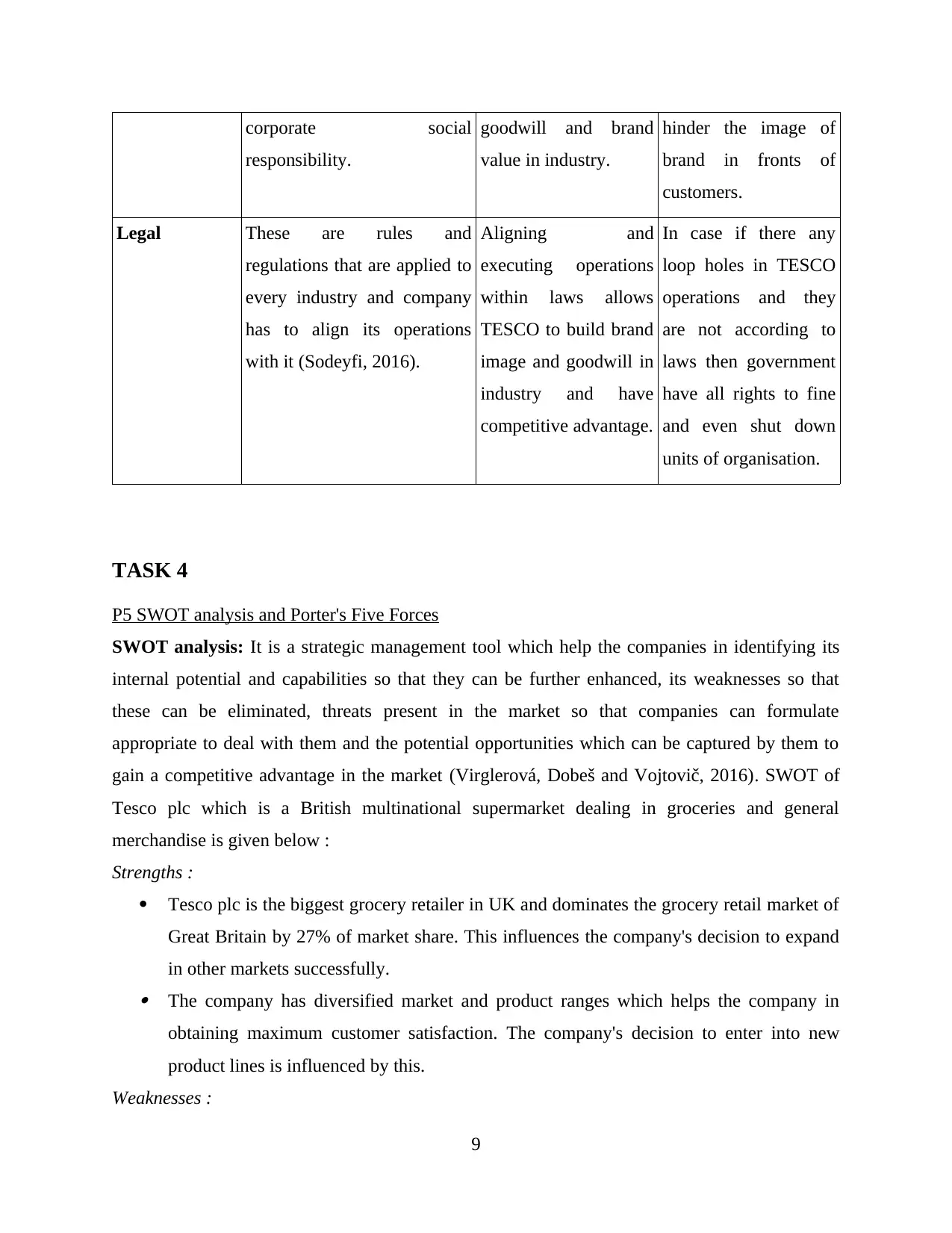
corporate social
responsibility.
goodwill and brand
value in industry.
hinder the image of
brand in fronts of
customers.
Legal These are rules and
regulations that are applied to
every industry and company
has to align its operations
with it (Sodeyfi, 2016).
Aligning and
executing operations
within laws allows
TESCO to build brand
image and goodwill in
industry and have
competitive advantage.
In case if there any
loop holes in TESCO
operations and they
are not according to
laws then government
have all rights to fine
and even shut down
units of organisation.
TASK 4
P5 SWOT analysis and Porter's Five Forces
SWOT analysis: It is a strategic management tool which help the companies in identifying its
internal potential and capabilities so that they can be further enhanced, its weaknesses so that
these can be eliminated, threats present in the market so that companies can formulate
appropriate to deal with them and the potential opportunities which can be captured by them to
gain a competitive advantage in the market (Virglerová, Dobeš and Vojtovič, 2016). SWOT of
Tesco plc which is a British multinational supermarket dealing in groceries and general
merchandise is given below :
Strengths :
Tesco plc is the biggest grocery retailer in UK and dominates the grocery retail market of
Great Britain by 27% of market share. This influences the company's decision to expand
in other markets successfully. The company has diversified market and product ranges which helps the company in
obtaining maximum customer satisfaction. The company's decision to enter into new
product lines is influenced by this.
Weaknesses :
9
responsibility.
goodwill and brand
value in industry.
hinder the image of
brand in fronts of
customers.
Legal These are rules and
regulations that are applied to
every industry and company
has to align its operations
with it (Sodeyfi, 2016).
Aligning and
executing operations
within laws allows
TESCO to build brand
image and goodwill in
industry and have
competitive advantage.
In case if there any
loop holes in TESCO
operations and they
are not according to
laws then government
have all rights to fine
and even shut down
units of organisation.
TASK 4
P5 SWOT analysis and Porter's Five Forces
SWOT analysis: It is a strategic management tool which help the companies in identifying its
internal potential and capabilities so that they can be further enhanced, its weaknesses so that
these can be eliminated, threats present in the market so that companies can formulate
appropriate to deal with them and the potential opportunities which can be captured by them to
gain a competitive advantage in the market (Virglerová, Dobeš and Vojtovič, 2016). SWOT of
Tesco plc which is a British multinational supermarket dealing in groceries and general
merchandise is given below :
Strengths :
Tesco plc is the biggest grocery retailer in UK and dominates the grocery retail market of
Great Britain by 27% of market share. This influences the company's decision to expand
in other markets successfully. The company has diversified market and product ranges which helps the company in
obtaining maximum customer satisfaction. The company's decision to enter into new
product lines is influenced by this.
Weaknesses :
9
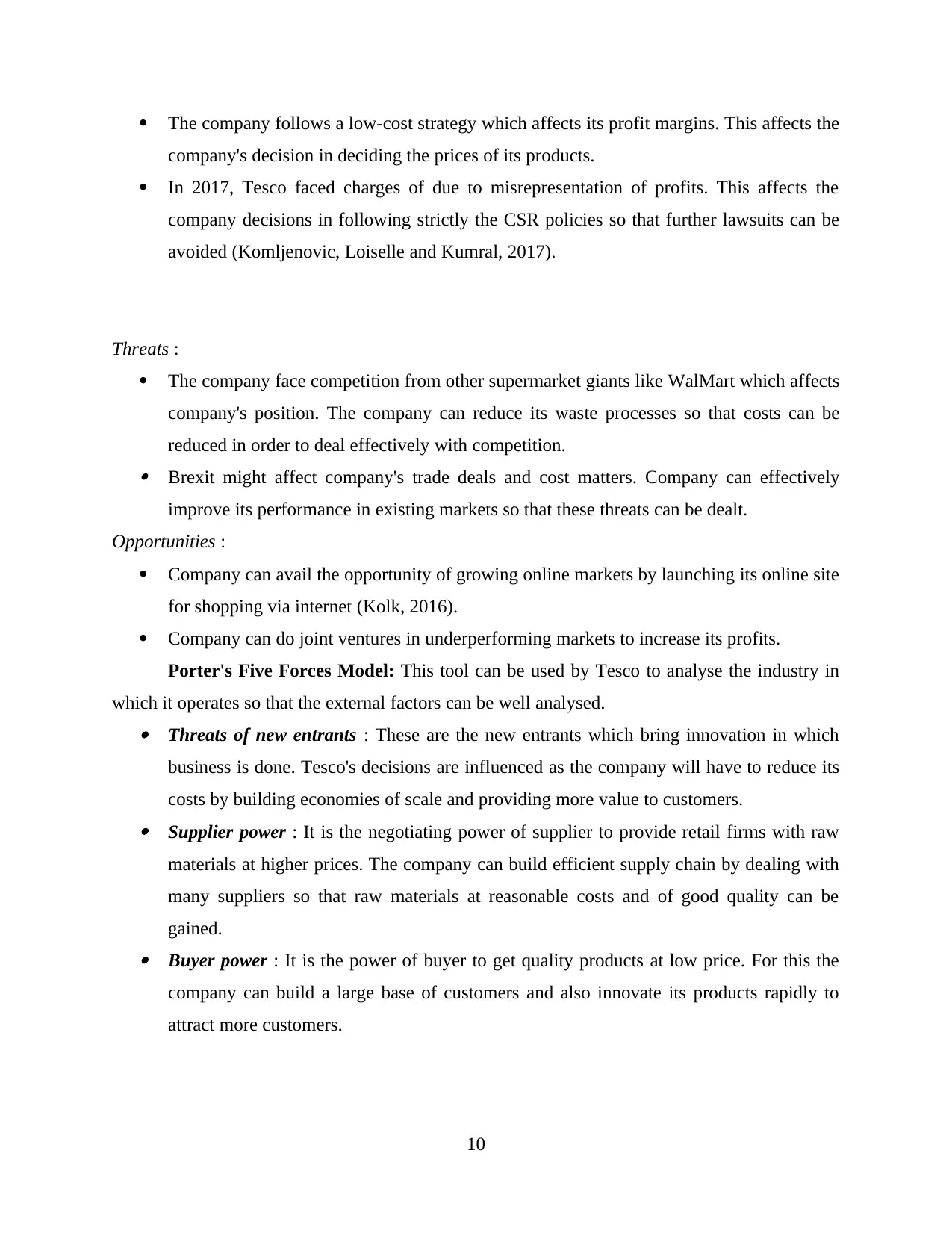
The company follows a low-cost strategy which affects its profit margins. This affects the
company's decision in deciding the prices of its products.
In 2017, Tesco faced charges of due to misrepresentation of profits. This affects the
company decisions in following strictly the CSR policies so that further lawsuits can be
avoided (Komljenovic, Loiselle and Kumral, 2017).
Threats :
The company face competition from other supermarket giants like WalMart which affects
company's position. The company can reduce its waste processes so that costs can be
reduced in order to deal effectively with competition. Brexit might affect company's trade deals and cost matters. Company can effectively
improve its performance in existing markets so that these threats can be dealt.
Opportunities :
Company can avail the opportunity of growing online markets by launching its online site
for shopping via internet (Kolk, 2016).
Company can do joint ventures in underperforming markets to increase its profits.
Porter's Five Forces Model: This tool can be used by Tesco to analyse the industry in
which it operates so that the external factors can be well analysed. Threats of new entrants : These are the new entrants which bring innovation in which
business is done. Tesco's decisions are influenced as the company will have to reduce its
costs by building economies of scale and providing more value to customers. Supplier power : It is the negotiating power of supplier to provide retail firms with raw
materials at higher prices. The company can build efficient supply chain by dealing with
many suppliers so that raw materials at reasonable costs and of good quality can be
gained. Buyer power : It is the power of buyer to get quality products at low price. For this the
company can build a large base of customers and also innovate its products rapidly to
attract more customers.
10
company's decision in deciding the prices of its products.
In 2017, Tesco faced charges of due to misrepresentation of profits. This affects the
company decisions in following strictly the CSR policies so that further lawsuits can be
avoided (Komljenovic, Loiselle and Kumral, 2017).
Threats :
The company face competition from other supermarket giants like WalMart which affects
company's position. The company can reduce its waste processes so that costs can be
reduced in order to deal effectively with competition. Brexit might affect company's trade deals and cost matters. Company can effectively
improve its performance in existing markets so that these threats can be dealt.
Opportunities :
Company can avail the opportunity of growing online markets by launching its online site
for shopping via internet (Kolk, 2016).
Company can do joint ventures in underperforming markets to increase its profits.
Porter's Five Forces Model: This tool can be used by Tesco to analyse the industry in
which it operates so that the external factors can be well analysed. Threats of new entrants : These are the new entrants which bring innovation in which
business is done. Tesco's decisions are influenced as the company will have to reduce its
costs by building economies of scale and providing more value to customers. Supplier power : It is the negotiating power of supplier to provide retail firms with raw
materials at higher prices. The company can build efficient supply chain by dealing with
many suppliers so that raw materials at reasonable costs and of good quality can be
gained. Buyer power : It is the power of buyer to get quality products at low price. For this the
company can build a large base of customers and also innovate its products rapidly to
attract more customers.
10
⊘ This is a preview!⊘
Do you want full access?
Subscribe today to unlock all pages.

Trusted by 1+ million students worldwide
1 out of 16
Related Documents
Your All-in-One AI-Powered Toolkit for Academic Success.
+13062052269
info@desklib.com
Available 24*7 on WhatsApp / Email
![[object Object]](/_next/static/media/star-bottom.7253800d.svg)
Unlock your academic potential
Copyright © 2020–2025 A2Z Services. All Rights Reserved. Developed and managed by ZUCOL.





